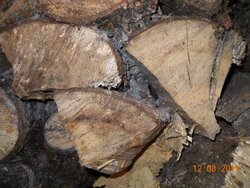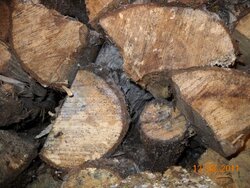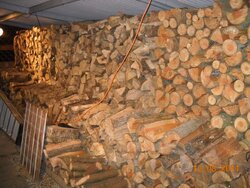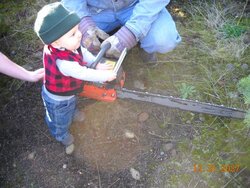I stacked all my wood in the wood shed in April. I sprinkled lawn insect killer pretty heavily under the pallets prior to stacking my wood. I have virtually no spiders in my wood pile, YAY! Late last summer about August, I noticed LOTS of yellow jackets flying into my stacked wood from the back side, but I could not find the nest. I knew it was a big nest, due to the large volume of yellow jackets coming and going all the time. I deployed two yellow jacket traps, and over a few weeks until fall, I caught 352 (yes, I counted them as I dumped the traps). I'd collect the traps after dark, and put the traps in the freezer. After a while, I could dump the traps, and redeploy. I tried hard to find that yellow jacket nest to no avail. I knew I would have to wait until it was cold out, and there was no longer yellow jacket activity to try to do anything. Trapping activity ceased about the first week of October with the cooler weather. The nest probably went into hibernation.
I finally used enough wood to find the hive. The yellow jacket nest is a very complex nest that just about engulfs one chunk of wood, and fills up all the air space between that chunk and the other pieces of splits. I'm still unsure if there are more parts of this nest that I just uncovered.
The question now is what should I do? What would you do? :ahhh:
I'm thinking on a sub-freezing evening after dark, I'll rip off the wood around the nest, and have the hornets spray ready. Once I expose the hive, I'll spray the heck out of it. Then, somehow dispose of it, although I'm not sure how yet. I'm thinking there must be hundreds more still in the hive. I don't think they will be active at night, and in sub-freezing weather. This is the first yellow jackets nest I've had in my wood piles, and I've burned wood since 1979. I guess I'm lucky. But if you have had "experience" with a yellow jackets nest in your wood pile, I'm inquiring of all you experts out there in Hearth.com Land.
I did go wood cutting one day above Dallas, Oregon about 20-25 years ago, and was cutting on a deck of wood, and ZAP, ZAP, ZAP, ZAP I got stung four times, Yowsers! I ran like no bodies business, and somehow managed to get my chain saw back, and quit cutting on that portion of the deck, and didn't get stung again that day. Also, I will get stung maybe once every two years bringing in wood, from a yellow jacket hibernating in cracks of my wood.
I've attached two pictures of the hive. Also, I have one picture of my wood pile. I've used about 25-30% of my wood thus far. Each row is just about 1.5 cords stacked to the roof. And the last picture I thought you would get a kick out of. It's me giving my grandson lessons how to fall his first fir tree (our Christmas tree). He'll probably need some more lessons.
Oregon Bigfoot
I finally used enough wood to find the hive. The yellow jacket nest is a very complex nest that just about engulfs one chunk of wood, and fills up all the air space between that chunk and the other pieces of splits. I'm still unsure if there are more parts of this nest that I just uncovered.
The question now is what should I do? What would you do? :ahhh:
I'm thinking on a sub-freezing evening after dark, I'll rip off the wood around the nest, and have the hornets spray ready. Once I expose the hive, I'll spray the heck out of it. Then, somehow dispose of it, although I'm not sure how yet. I'm thinking there must be hundreds more still in the hive. I don't think they will be active at night, and in sub-freezing weather. This is the first yellow jackets nest I've had in my wood piles, and I've burned wood since 1979. I guess I'm lucky. But if you have had "experience" with a yellow jackets nest in your wood pile, I'm inquiring of all you experts out there in Hearth.com Land.
I did go wood cutting one day above Dallas, Oregon about 20-25 years ago, and was cutting on a deck of wood, and ZAP, ZAP, ZAP, ZAP I got stung four times, Yowsers! I ran like no bodies business, and somehow managed to get my chain saw back, and quit cutting on that portion of the deck, and didn't get stung again that day. Also, I will get stung maybe once every two years bringing in wood, from a yellow jacket hibernating in cracks of my wood.
I've attached two pictures of the hive. Also, I have one picture of my wood pile. I've used about 25-30% of my wood thus far. Each row is just about 1.5 cords stacked to the roof. And the last picture I thought you would get a kick out of. It's me giving my grandson lessons how to fall his first fir tree (our Christmas tree). He'll probably need some more lessons.

Oregon Bigfoot





